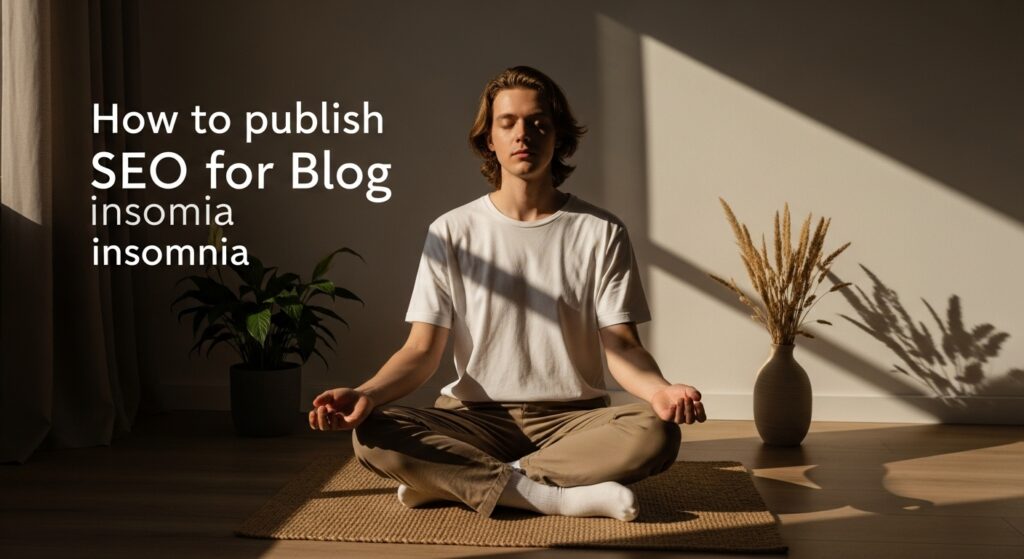How to Publish SEO for Blog Insomnia: A Holistic Guide to Better Sleep and Traffic
Estimated reading time: 8 minutes
Key takeaways
- Target insomnia, sleep disturbance, and Belsomra as keywords
- Structure posts with H2/H3 headers for readability
- Use internal links to related content
- Promote via social media & email
- Keep learning with expert SEO guides
Table of contents
- Introduction
- Why SEO Matters for Insomnia Blogs
- Step 1: Keyword Research for Insomnia Content
- Step 2: Crafting an Engaging, SEO-Optimized Blog Post
- Step 3: Optimizing for User Experience & Engagement
- Step 4: Promoting Your Insomnia Blog
- Final Thoughts: SEO for Long-Term Success
- FAQ
Introduction
Struggling with insomnia or sleep disturbances can be exhausting—both for your health and your blog’s visibility. If you run a wellness blog focused on sleep disorders like familial insomnia or hypersomnia, mastering SEO (Search Engine Optimization) is crucial to reaching the right audience.
In this guide, we’ll walk you through the exact process to optimize your insomnia-related blog posts for search engines, drive organic traffic, and even recommend holistic sleep aids like Belsomra (a prescription sleep aid) alongside natural remedies.
Whether you’re a holistic health writer or a digital marketer, this step-by-step SEO guide will help you rank higher, attract engaged readers, and monetize your content effectively.
Why SEO Matters for Insomnia Blogs
If you’re writing about insomnia, sleep disorders, or holistic sleep remedies, your audience is actively searching for solutions. Proper SEO ensures your content appears when they need it most.
According to Michigan Tech’s SEO guide, a well-structured SEO strategy helps:
- Improve search rankings for sleep-related keywords
- Increase organic traffic from people struggling with insomnia
- Build authority in the holistic wellness niche
A Reddit thread on scaling SEO for startups also highlights that consistent, high-quality content is key—especially in competitive niches like sleep health.
Step 1: Keyword Research for Insomnia Content
Before writing, identify the best insomnia-related keywords your audience is searching for. These may include:
- Primary keyword: “insomnia”
- Secondary keywords: “sleep disturbance,” “hypersomnia,” “familial insomnia,” “Belsomra”
- Long-tail queries: “natural remedies for insomnia,” “how to fall asleep faster”
Tools like Google Keyword Planner or Ubersuggest can help refine your list.
Pro Tip:
Check this Reddit discussion on overlooked SEO tips to avoid common keyword mistakes.
Step 2: Crafting an Engaging, SEO-Optimized Blog Post
Once you have your keywords, structure your post for readability and SEO.
A. Headline & Introduction
Your title should include your main keyword, like:
“How to Publish SEO for Blog Insomnia: A Holistic Sleep Guide”
The introduction must hook readers while naturally integrating keywords. Example:
“If you’ve ever struggled with insomnia or sleep disturbances, you know how frustrating it can be. This guide will help you optimize your sleep blog for search engines while offering science-backed remedies—from Belsomra to natural relaxation techniques.”
B. Body Content & Subheadings
Break your content into digestible sections with H2 and H3 tags that include keywords:
H2: Understanding Insomnia and Sleep Disorders
- Define insomnia, hypersomnia, and familial insomnia
- Discuss medical treatments like Belsomra vs. holistic approaches
H2: SEO Best Practices for Sleep Blogs
- On-page SEO: Meta descriptions, alt text for images
- Internal linking: Link to related posts (e.g., biohacking sleep science)
- External linking: Cite authoritative sources (e.g., Medium’s blog writing guide)
H2: Monetizing Your Insomnia Blog
- Affiliate marketing for sleep aids (e.g., Belsomra, melatonin)
- Sponsored posts from wellness brands
Step 3: Optimizing for User Experience & Engagement
A. Readability
- Use short paragraphs, bullet points, and visuals
- Break up text with pull quotes or statistics
B. Internal Linking Strategy
Link to related content on your blog, such as:
- Energy cleansing techniques for relaxation
- Morning routines for success to improve sleep hygiene
C. Call-to-Action (CTA)
Encourage readers to:
- Download a free sleep guide
- Join your newsletter for more holistic sleep tips
Step 4: Promoting Your Insomnia Blog
SEO doesn’t end with publishing. Promote your post via:
- Social media (Pinterest, Reddit sleep communities)
- Email marketing (share with subscribers interested in sleep remedies)
- Guest posting on wellness blogs
Final Thoughts: SEO for Long-Term Success
Optimizing your insomnia blog for SEO takes effort, but the payoff is worth it. By targeting the right keywords, structuring content effectively, and leveraging internal links (like biohacking sleep science), you’ll attract more readers and grow your authority in the sleep wellness niche.
For more SEO insights, check out:
Now, go optimize your insomnia blog—and maybe get some better sleep while you’re at it!
FAQ
What are the best keywords for an insomnia blog?
Target primary keywords like “insomnia” and secondary terms such as “sleep disturbance,” “hypersomnia,” and “Belsomra.” Long-tail queries like “natural remedies for insomnia” also perform well.
How can I improve readability in my sleep blog posts?
Use short paragraphs, bullet points, and subheadings (H2/H3). Break up text with visuals or pull quotes for better engagement.
What are some effective ways to promote an insomnia blog?
Leverage social media, email marketing, and guest posting on wellness blogs. Engage with communities like Reddit’s sleep forums for targeted reach.

